

MINI JOINS THE WORLD RALLY CHAMPIONSHIP
The FIA World Rally Championship has been labelled as one of the toughest motor-sport competitions in the world, ever since its formation in the early 1970s. It hosts thirteen events in thirteen different countries over four continents every year, pushing the drivers, the teams and of course the cars themselves to the very limit. Like most forms of motor sport, the WRC is broadcast on international television, so many people are aware of the variety of surfaces the cars compete on at each venue. From ice and snow to tarmac and dirt tracks, all of which are made even more challenging in the event of heavy rain, scorching sunshine or roads littered with rocks and other objects, it is no wonder the championship has been dubbed one of the most challenging events in history.
For many motor-sport enthusiasts, the arrival of the new BMW MINI brand at the championship was a symbolic and monumental occasion, because it marked the return of the victorious name to the sport after the courageous Cooper S took three victories in the Monte Carlo Rally. Entering the championship would be MINI’s significantly larger JCW Countryman, which came with the optional all-wheel-drive facility: just the tool for rallying. Motor-sport experts at the British motor-sport firm Prodrive in Oxfordshire, were chosen to build and prepare the two John Cooper Works cars. The motor-sport preparation company won three drivers’ and manufacturers’ titles with the likes of rally legend Colin McRae, when it ran Subaru’s WRC team between 1990 and 2008. Prodrive is therefore labelled as one of the world’s largest motor-sport and technology businesses.
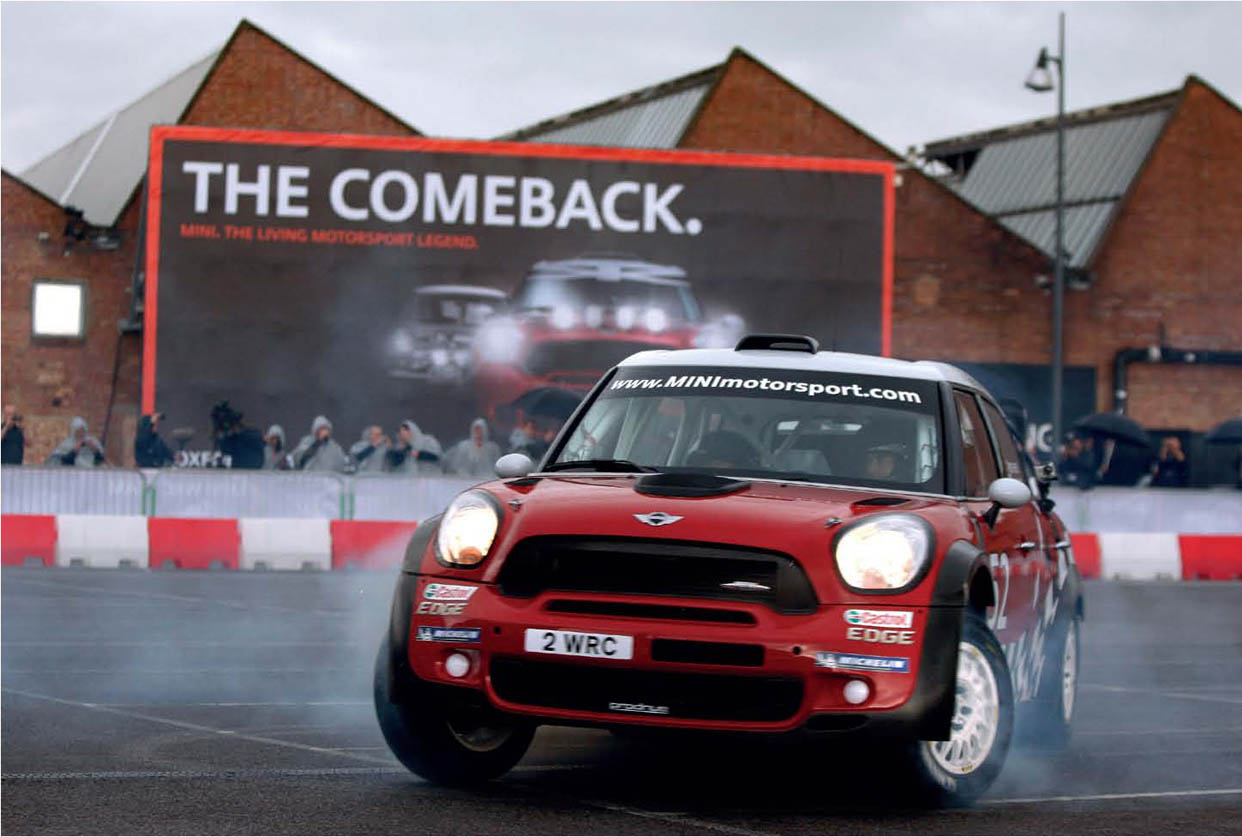
The arrival of the new MINI brand to championship was a symbolic occasion, marking the brand’s return to rallying. NEWSPRESS
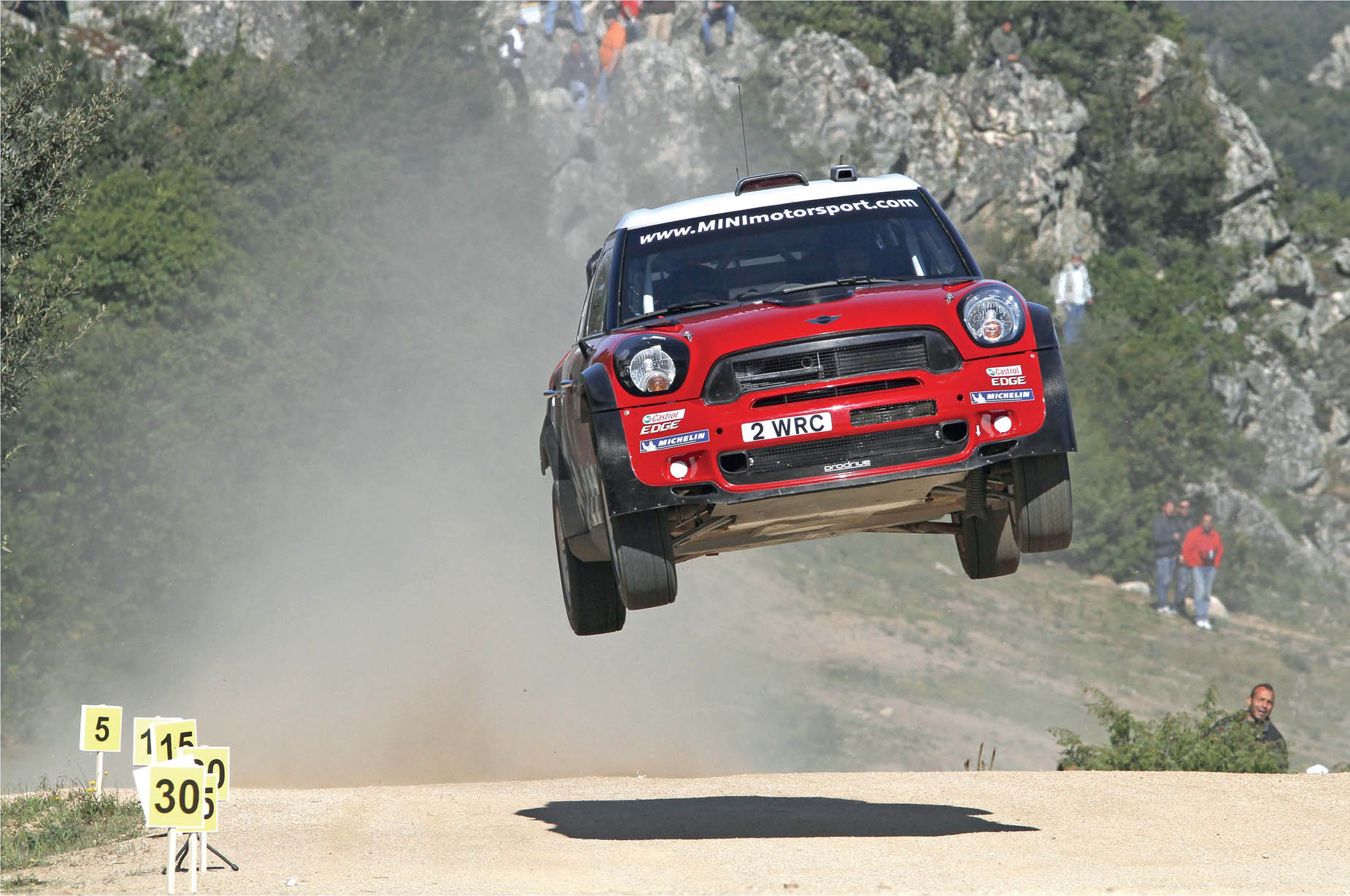
Based on the Countryman, the WRC MINI’s direct injection 1.6-litre turbocharged engine has been developed by BMW Motorsport for use in other motor-sport series. NEWSPRESS
In September 2010, BMW MINI launched its first FIA World Rally (WRC) car, in the form of a heavily modified and revamped MINI Countryman, at the Paris Motor Show. In doing so, the car maker also confirmed British rally driver Kris Meeke as a key figure in its driver line-up for the 2011 season. The car would be prepared, run and maintained by Prodrive. Although it is based on the MINI’s Countryman, the WRC version features a direct injection, 1.6-litre, turbocharged, in-line 4-cylinder engine, which has since been developed by BMW Motorsport for use in other motor-sport series, including the FIA World Touring Car Championship.
The fact that the MINI name would be returning to the rally stages was music to many motor-sport enthusiasts’ ears: but would it live up to the classic that went on to win the famous Monte Carlo Rally three times? The pressure was on. Ian Robertson, BMW AG board member of sales and marketing, commented on the news: ‘The response to our announcement that MINI will return to the world of rallying next year was very positive. The FIA World Rally Championship is the pinnacle of rallying, making it the ideal platform for demonstrating the competitive spirit of our brand.’
Dave Richards, chairman of Prodrive, also commented: ‘This project is a truly passionate opportunity. Mini is a cult brand, which left a lasting impression during its previous motor-sport campaigns. We are both extremely happy and proud to be on board as a partner when MINI returns to rallying.’
The Countryman-based S2000 rally car was unveiled in Monaco at the end of the historic Monte Carlo Rally, where former Monte winner Rauno Aaltonen and his BMC teammate and fellow Monte winner Paddy Hopkirk, with the legendary Cooper S, were joined by drivers Kris Meeke and Dani Sordo, who would pilot the modern MINI. Parked together, the vast difference between the two cars is clear to see, and how the iconic small car had evolved into what we’d call a big iconic car.
It was in April 2011 that the MINI WRC team officially presented the MINI John Cooper Works WRC car at MINI Plant Oxford, in preparation to take on the 2012 World Rally Championship. As well as being based on the Countryman production model, the JCW WRC is also powered by the same 1.6-litre turbocharged engine used in the MINI production cars. The only difference is that the engine had been developed by BMW Motorsport to comply with FIA Super S2000 regulations.
The Rally Dakar is the most fascinating rally event on the international motor-sport calendar; its founder was Thierry Sabine, who once described this inspirational rally as ‘A challenge for those who go on; a dream for those who stay behind.’ Since it all began in 1978, drivers in cars and trucks, on quads and motorcycles, have made their way through the desert to compete in the world’s most infamous endurance rally. And yes, the MINI name is once again in the line-up. Up until 2008, the Rally Dakar was held exclusively in Africa and was initially known as the ‘Paris-Dakar Rally’ due to the location of its start and finish. But over time, these locations have continued to change several times, and what was known as the ‘Paris-Dakar Rally’ became simply ‘Dakar’ when the rally began in locations other than Paris. In 2009 the event was moved to southern America, where it has remained ever since.
The X-raid team won the Rally Dakar for the first time in 2012, when eleven-times winner of the rally, Stephane Peterhansel, took the title and claimed his tenth overall victory at the wheel of a MINI ALL4 Racing. In 2013 he returned again to defend his title, taking victory once again in the same car. The Frenchman is the record winner of the endurance rally, and is nicknamed ‘Mr Dakar’. In August 2013 he also dominated the Rally dos Sertoes in Brazil, winning eight out of ten legs to finish 1 min 49sec ahead of second place. In fact the Rally dos Sertoes is spoken of as one of the most challenging events on the off-road calendar. Taking place on a range of terrain from sand and stones to grassland, it consists of stages up to 319 miles (514km) and a marathon stage of more than 566 miles (911km), of which 404 miles (650km) are timed.
MINI HITS THE CIRCUITS
Looking back, the little Mini was also highly successful on the tarmac circuits, achieving a number of wins in the 1960s and 1970s. It actually became the most outstanding racing car of the entire 1960s decade, with many racing careers starting behind the wheel of a Mini. An example includes Austrian driver Nikolaus Andreas Lauda, known by many today as the one and only Niki Lauda, who entered his first hill-climb race in a classic Mini in 1968 – and he came second. Lauda of course went on to win three Formula One World Championships. Like Lauda, Formula One champions John Surtees, Jackie Stewart, James Hunt and Graham Hill all gained their first racing experiences in classic Minis – and there are many today who still believe that the Mini is the ultimate car in which to get to grips with motor sport.
Since its launch as the MINI Challenge in 2005, this fast-paced form of motorsport has become firmly established as one of the most popular single-make championships in the UK due to its combination of class structure and cost effectiveness. As with any form of Mini or MINI racing, its success is often due to the car’s ability to offer drivers ‘go-kart handling and feeling’.
The club sport series has become known and loved among many teams and drivers internationally, with races held in Germany, Argentina, Switzerland, Italy and the UK – and what’s more, the MINI Challenge is one of the most accessible series, in that fans of Mini or MINI can easily get close to the drivers and teams in the paddock, unlike the politically controlled Formula One World Championship.
The UK championship has twenty races across seven weekends in a season, with eight teams battling it out on track for the championship title. The grid is divided into two classes, the JCW Class and the Cooper Class – this means that fully fledged John Cooper Works cars run on one half of the grid, while Coopers remain on the other half. 2005 was the year the original John Cooper Challenge entered its first year as the MINI Challenge. Between 2006 and 2009, the Cooper S made its way on to the grid, where it would later be followed by the JCW, based on the R56 S, in 2010.
The cars are specially equipped for motor racing, and are assembled centrally by MINI to avoid any forbidden modifications, which could lead to disqualification. Therefore, each class in the series consists of equal and identical technical specifications for all drivers and all teams, making for what the series itself calls ‘door-to-door duels in the races’ and ‘no advantage, no disadvantage, no excuses’. The JCW cars benefit from a performance upgrade in the form of an ECU remap from DNA Tuning, to improve throttle response and provide more torque.
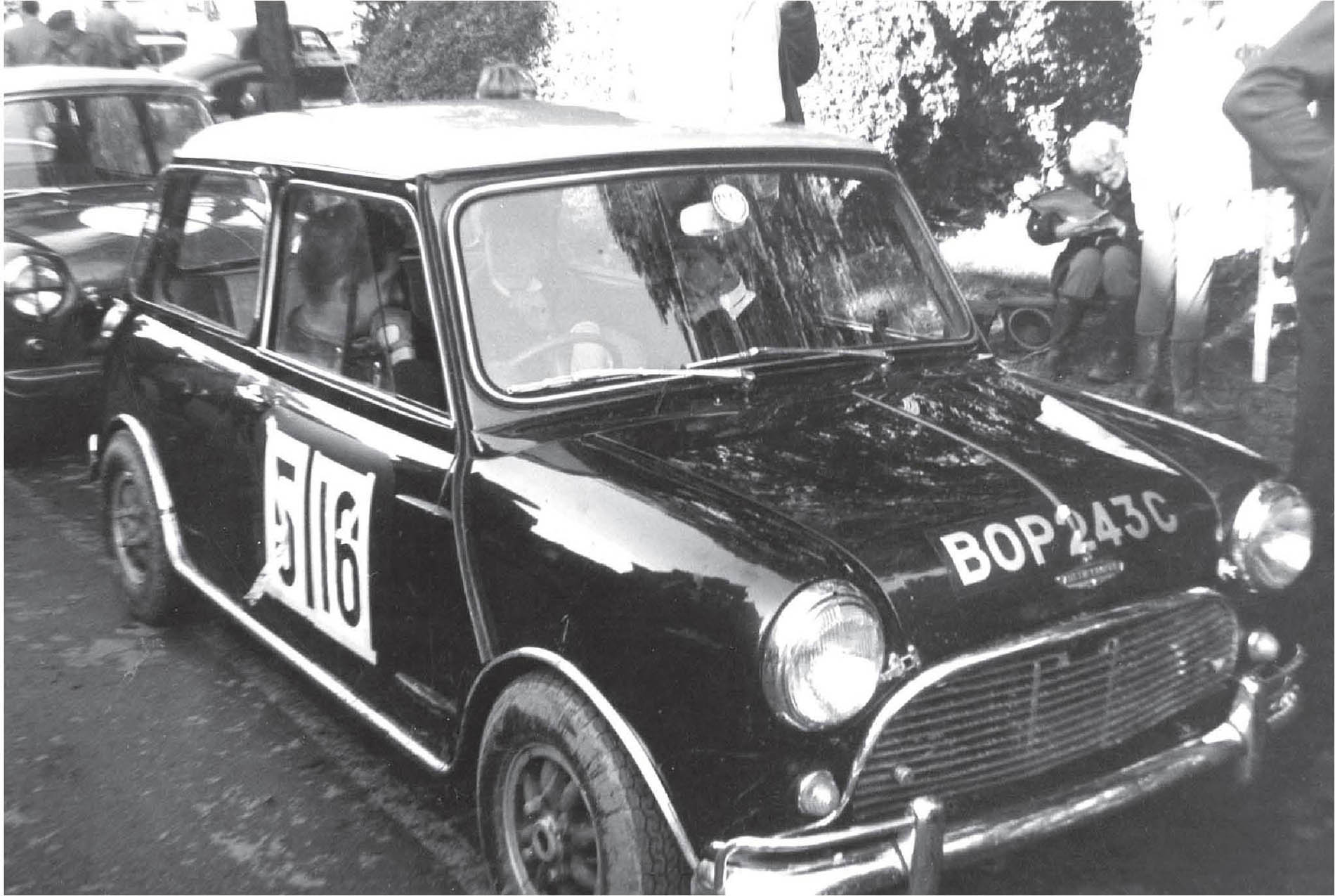
An early 1960s Austin Mini preparing to hit the circuit. ERIC WALKER, SUPPLIED BY GUY LOVERIDGE
JCW cars are based on the foundations of the turbocharged R56 Cooper S, using exactly the same powertrain found on the standard road cars. The engine is a 1.6-litre, in-line, 4-cylinder unit – similar to that of the MINI WRC car – fitted with a twin scroll turbocharger and direct fuel injection. This block produces 215bhp, but in order to achieve sportier levels of performance on the track, the engine was tuned and optimized accordingly. Its maximum torque of 260Nm is set to deliver between 1,850 and 5,700rpm, making it accessible across the entire rev range. On overboost, this figure increases to 280Nm and a power-to-weight ratio of 5.09kg; the Challenge MINI is actually up at the top of the league table with high performance sports cars.
In 2013 there were more than thirty registered drivers in the MINI Challenge, making it one of the most competitive grids in motor sport. The Cooper Class in particular was at its largest in 2013, and the winner earns themselves a JCW Class drive in the forthcoming season worth more than £ 16,000, along with other prizes for race winners. What many spectators adore to see is the pedigree Coopers stealing the limelight from the modern turbo machines.
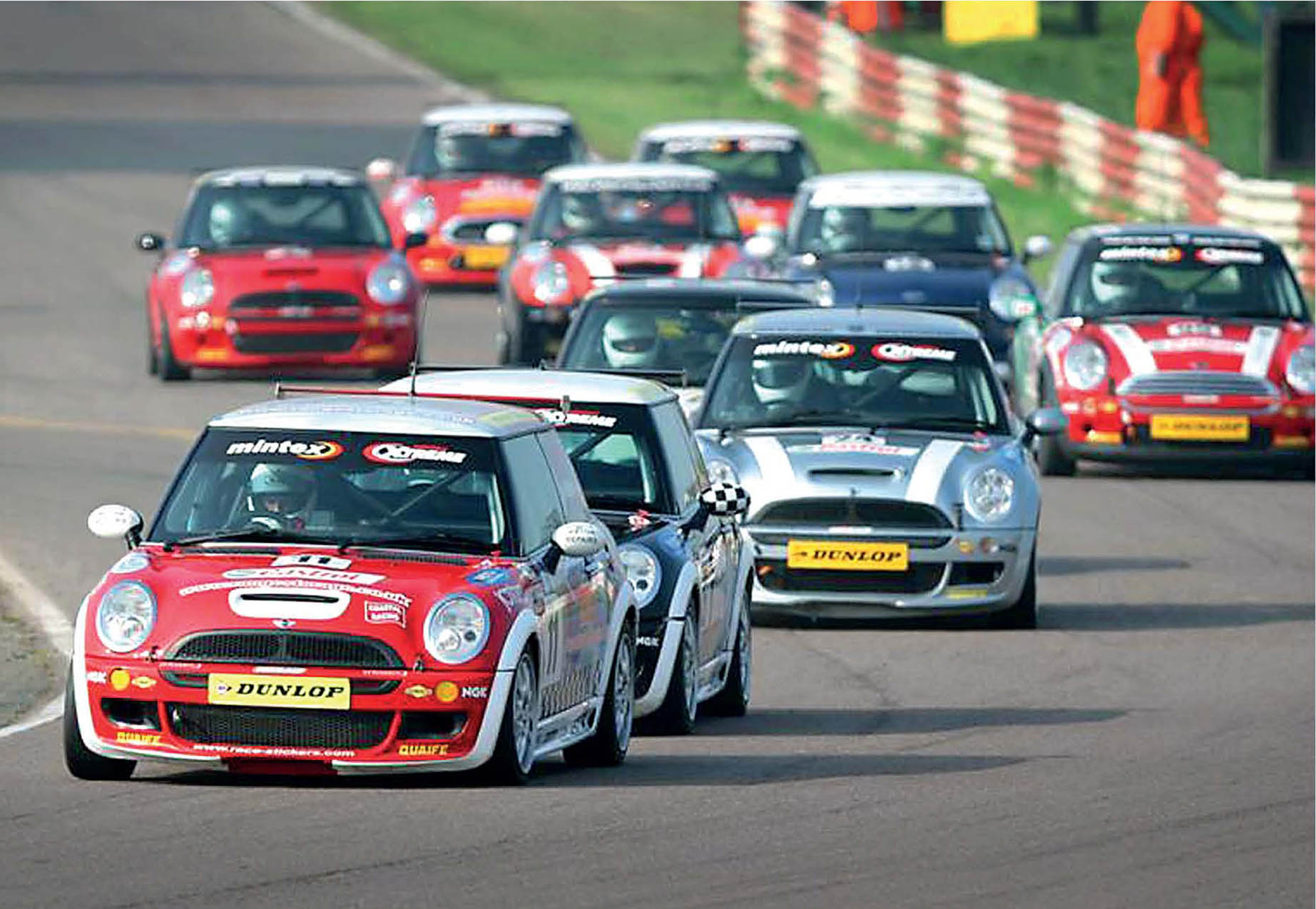
Since its launch in 2005, the MINI Challenge has become firmly established as one of the most popular single-make championships in the UK. NEWSPRESS
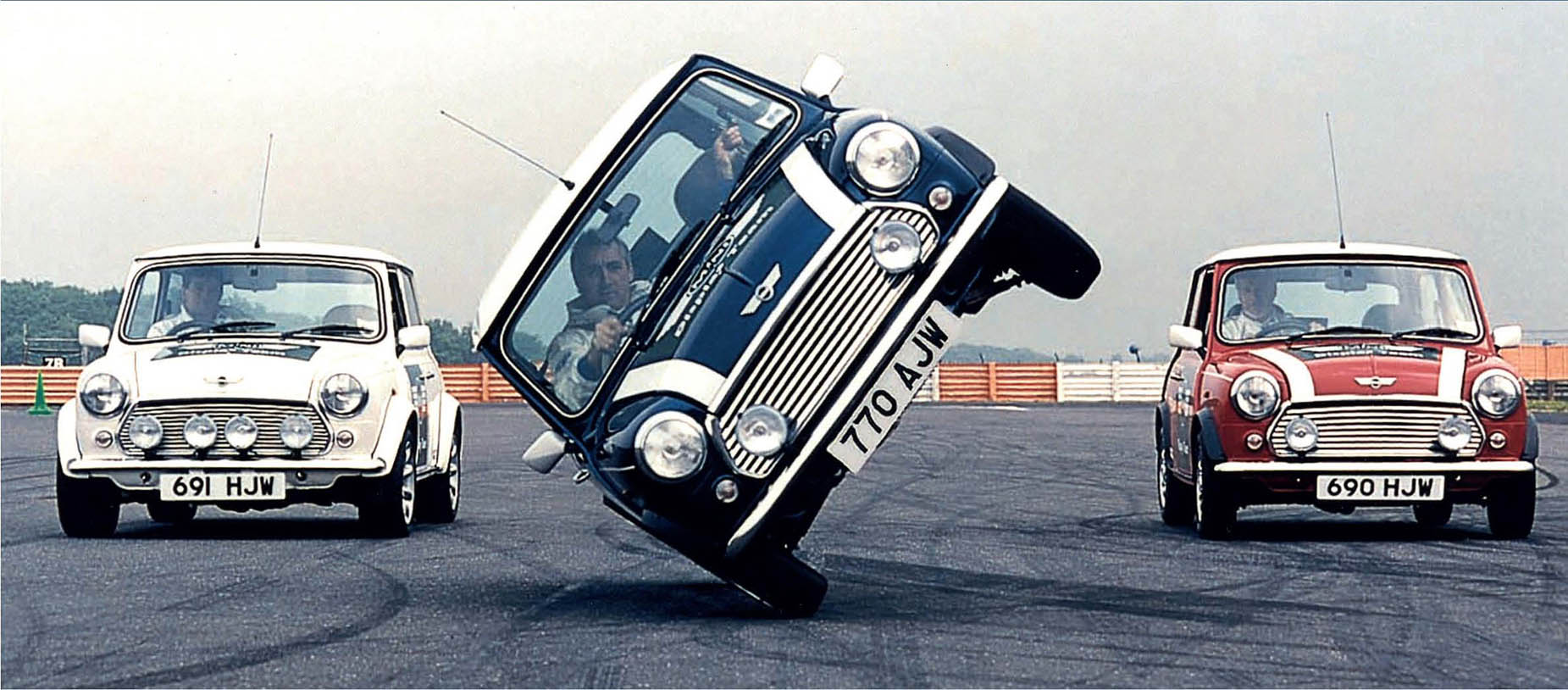
Russ says the reason behind Mini’s invincibility in Autotesting is its size, handling, precise steering, light weight, low power-to-weight ratio and superb traction.
Q: The Russ Swift Mini Display Team was formed in 1981, but you have been involved in motor sport since the early 1970s. After being a co-driver for a number of years, you got behind the wheel in 1972. What was it about the Mini that made it the ultimate racing car?
A: My first six motor-sport events were in a Mini as a co-driver, so I have always had an affinity with them. As I couldn’t afford to rally or race, my chosen sport was Autotesting. My first events as a driver were in a VW Beetle, but I soon realized that if I was to get to the top it had to be in a Mini. The reason for its invincibility in Autotesting is its size, handling, precise steering, light weight, low power-to-weight ratio and superb traction, and the availability of a massive range of quality performance enhancements.
Q: Have you always been a Mini owner in terms of road cars, race cars and stunt cars? In your opinion, what makes the Mini/MINI such a desirable car, even now in 2014 following the fiftieth anniversary celebrations of the legendary Cooper S last year? Is it because they’re so accessible to everyone?
A: I had been driving for seven years before I bought my first Mini, for the reasons described above. Even to this day, the ultimate Autotest car is a classic Mini. I have always had at least one personal Mini since then. The car I built for Autotesting in 1980 will hopefully be kept for the third generation of Swifts. This car won four national championships for me and an international rally in Sweden before being campaigned by my son with equal success.
I have owned over a hundred Minis over the years, and I still have a 1990 Mini Cooper RSP (Rover Special Products) – it was the first Mini Cooper to be produced after production ceased twenty years earlier, and is chassis number 00001. I first used it in a TV commercial to announce the re-introduction of the Cooper range. I was then asked by Rover to convert it into a cabriolet as they were considering introducing one to the model range. I have previously chopped the roofs off Minis for Autotesting for increased visibility and reduced weight, and adapted the design for a road car. It proved a massive success, and I converted forty-five cars in the mid-eighties, and would have continued to do so if the demand for my displays hadn’t been so great.
The car was used in a design exercise at Warwick University to determine the style of the cabriolet eventually to be released by Rover a couple of years later. In the early 1990s, at the end of the exercise, the car was returned to me for display duties. It was eventually offered to me by Rover, and apart from a brief spell when I sold it to a museum, I have owned it ever since. It has still only completed under 300 miles (480km), most of them on two wheels. I operated a ‘Mini Display Team’ for Austin Rover and Rover until the end. I performed at twenty-fifth, thirtieth, thirty-fifth and fortieth Mini anniversary festivals, as well as at hundreds of other major events in the UK and Europe.
The Mini appeals to people on so many different levels. It is a brilliant design, has a rich motor-sport heritage, is great fun to drive, has a unique and attractive shape, lends itself easily to personalization, and is still in plentiful supply.
Q: What was the atmosphere like from the crowds when you used to perform stunts in the classic Minis? The Mini is an easy car to throw around, especially at high speeds into corners… is it just as easy to get them up on two wheels? Which of your many stunts is your favourite to perform behind the wheel of a Mini?
A: Audiences love to see me perform in classic Minis. Performing in standard specification vehicles was never easy – 12in wheels made the steering very heavy and compromised stability. A standard spec classic Mini isn’t the easiest car to drive on two wheels either, as its low centre of gravity means the balance angle is quite high and the heavy steering requires considerable effort.
My favourite manoeuvre in any car is ‘swift parking’. I came up with this manoeuvre in a 1988 ‘car park’ commercial for the Montego. It is my signature move and has been imitated all over the world, and is the manoeuvre that boosted my popularity enormously. It is particularly effective in a Mini. The responsiveness of the Mini enables me to handbrake it to within an inch of a given spot with complete confidence.
Q: Looking at the new MINI, what are your thoughts on BMW’s efforts to recreate a classic – in your experience of working with the new car, do you think they have been successful in replicating the original car’s handling, personality and characteristics?
A: I think BMW has succeeded in producing a first-class car in the image of the classic Mini. Much of its success must be down to people’s affection for the classic. The car’s handling is excellent, but due to its size it will never match the manoeuvrability of the original. BMW have drawn on the history of people personalizing their Mini to much success. The classic Mini was designed fifty-five years ago, which is a very long time in the motor industry – think what was being produced fifty-five years before 1959. BMW’s Mini is better in almost every area, but only time will tell if it will achieve the exalted classic status of the original.
Q: BMW has certainly managed to maintain the ‘Mini spirit’, and I’m sure it will be successful long into the future. How many MINIs do you work with at Russ Swift Precision Driving? Do they attract as much attention and admiration from the crowds as the classic? Would you agree that they’re just as fun to drive as the classic, just with a little more padding and protection?
A: I have operated the MINI Display Team since its launch to the press and dealers in 2001. I am provided with two new MINI Cooper S models every year: one is used for two wheeling only, the other is used for everything else, and my displays are as popular as ever. Only the diehard classic Mini fans would like to see me still using the original. The BMWs are easier to drive in my displays due to their power steering, and are just as much fun. My concern for the future is the additional technology being introduced with every new model. I was very pleased to see that the latest model doesn’t incorporate a handbrake that is an electric button.
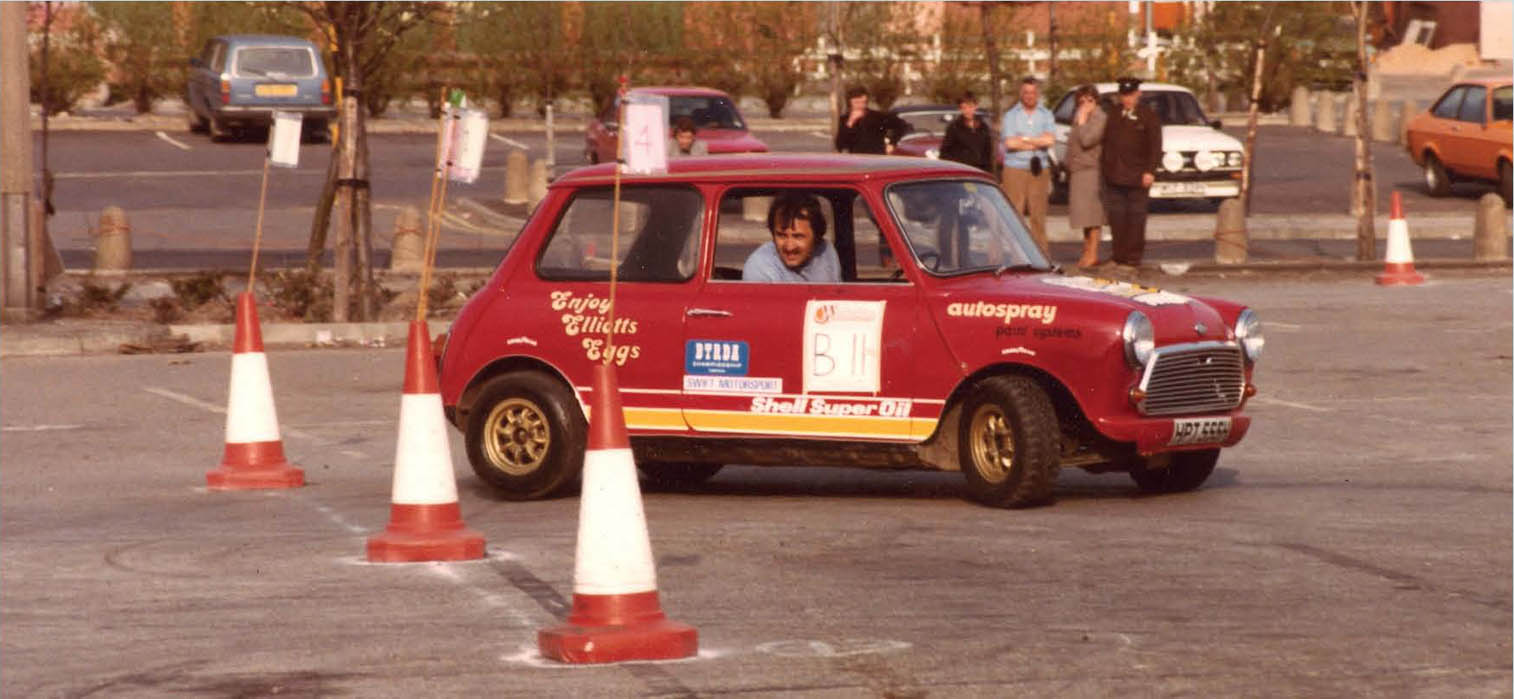
Russ Swift becomes the British Autotest Champion in 1983.
Q: The original Mini won the Monte Carlo Rally three times in four years: 1964, 1965 and 1967. Now the BMW MINI is competing in all forms of motor sport, from the WRC through to the Mini Challenge. Are you pleased to see the new BMW MINI on the race track and clearly achieving great success like its predecessor?
A: It’s great to see the BMW MINIs being used extensively in motor sport, though I don’t think their rallying involvement will ever emulate the promotional value of the original. The cars used in the sixties were modified but still relevant to the car you could purchase.
Q: What do you think to BMW’s approach of producing various different MINI models to expand the MINI range such as the Clubman, Clubvan, Countryman, Paceman and Coupé, which replicate the previous cars of the past? Have you driven all/most of the MINI models, or mainly the hatchback? What do you think to the larger creations, such as the Countryman?
A: BMW is doing a fantastic job of capitalizing on the warmth and affection the public has for anything related to the classic model. It is good commercial sense, and to be expected when a manufacturer buys into an existing brand. I don’t have any extensive experience of models other than the Cooper S hatch, but they are, after all, BMWs, and I am sure will be very high quality vehicles in their own right.
Q: Do you think it’s fair to say that BMW have produced another legendary car, albeit not quite as small as the original, that will go on to steal many motorists’ hearts? Is there anything the new MINI is missing that only the little classic Mini can offer?
A: The BMW MINI has proved to be an enormous success and has a massive following internationally, much greater than the original. There are fantastic events being held for the marque all over the world, and they are giving many people much pleasure, much as the classic did. Long may it continue. It is lovely to see the reverence paid to the classic model by BMW MINI enthusiasts. The BMW is a very sophisticated, high quality car, but even the introduction models are not cheap. The original Mini was aimed at making motoring possible for the masses, an affordable alternative to a motorcycle and sidecar. They are different concepts altogether. In fact it is remarkable that the original Mini went on to be so loved that BMW wanted the brand.
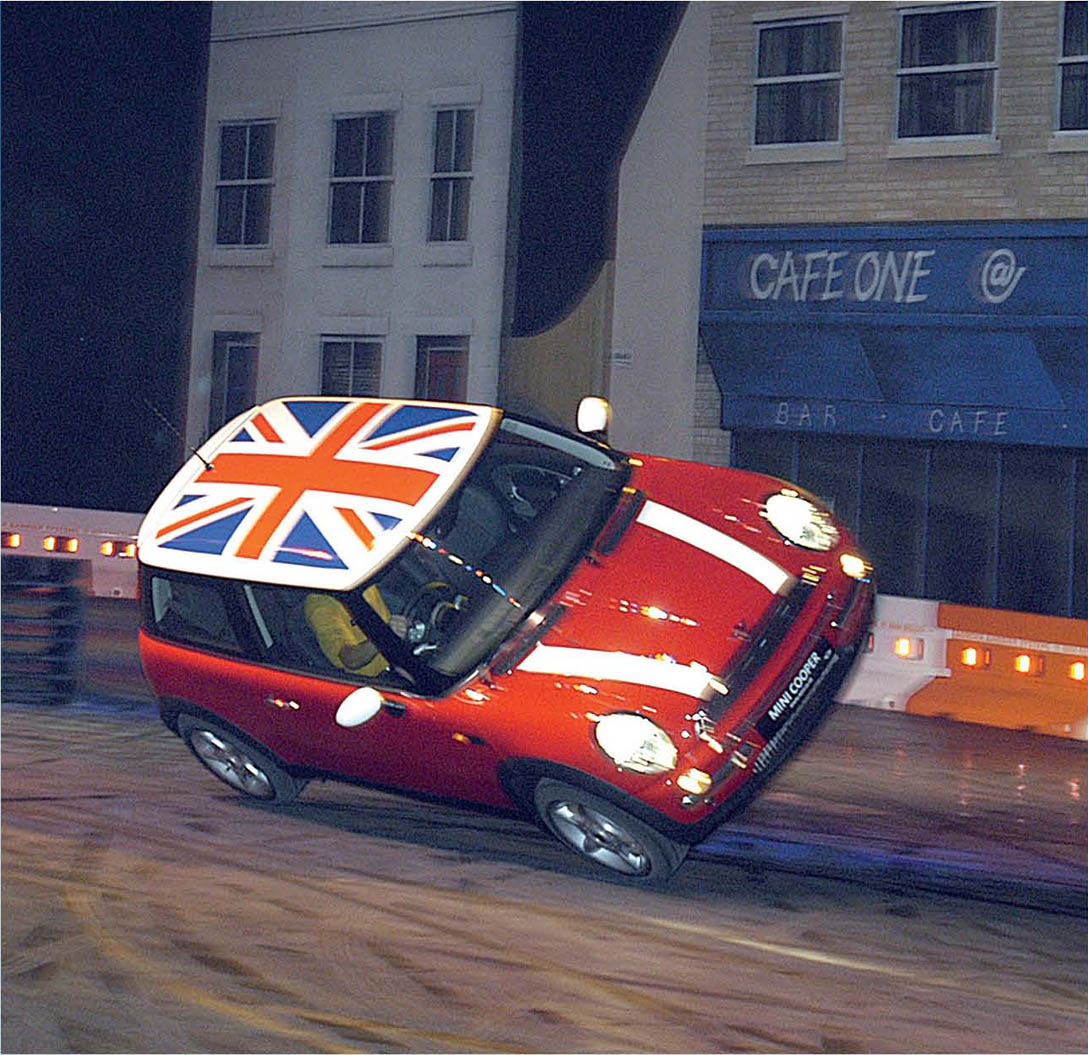
Swift says: ‘BMW has succeeded in producing a first class car in the image of the classic Mini.’ NEWSPRESS
Q: BMW has just unveiled and launched the all-new third generation MINI, which, like the previous generation, will come in MINI One, Cooper, Cooper S and John Cooper Works specifications. What are your thoughts on the manufacturer’s next big leap? Have you driven one? In terms of looks and/or driver satisfaction, do you still see a reflection of its predecessor?
A: I took delivery of my first generation model last week. It is obviously a state-of-the-art, very high quality, small(ish) car. I haven’t driven it in anger yet, so can’t comment on its full potential. It still retains styling cues from the original, as would be expected.
Q: Finally, in your experience with the BMW MINI, what has been your ultimate/favourite adventure? Is there a particular MINI you work with that you’ve grown very fond of over the years? If yes, what is it and why?
A: My favourite experience with the BMW MINI was performing at the British Motor Show in 2004. I devised a three-car routine, which I performed several times a day with my son Paul. It was the first time live action had been included in the show, and was a massive success.